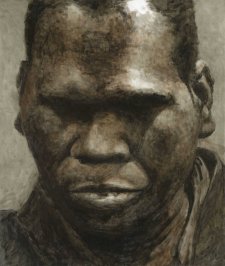- About us
- Support the Gallery
- Venue hire
- Publications
- Research library
- Organisation chart
- Employment
- Contact us
- Make a booking
- Onsite programs
- Online programs
- School visit information
- Learning resources
- Little Darlings
- Professional learning
2 minutes 10 seconds
This portrait of Gumatj man and musician Gurrumul is a large monotone painting. It is made with oil on linen, surrounded by a simple two-centimetre-wide black frame. The painting itself is one hundred ninety-eight centimetres by hundred and sixty seven centimetres.
Gurrumul's face centrally occupies the frame, leaving minimal room for background detail, indistinct light grey brushstrokes behind his neck and face. The image is made with variously dense, watery and inconsistent brush strokes, creating a allayed three dimensional quality in rich tones of black and gray that construct a voluminous contemplative face.
Gurrumul is front facing, his head tilts down until his right. Light spills to the left side of his face, tumbling down his forehead, eyebrow, cheek and lips. Cut off at the forehead, his peaked hairline just appears that the top. On his left upper forehead, a circular shape of white untouched canvas indicates the light source. Short curly black hair frames his head.
On Gurrumul's left between his hairline and ear lobe, a fine line of side burn arcs in unison with the extended line of his full, high cheekbone in contrast with his fleshy left ear behind it, the lines of which undulate and small irregular soft folds.
Below the thick overhang of eyebrows, Gurrumul's eyes are concealed in shadow. His cheeks are full and prominent. The contrast of light and darkened eyes imbues the portrait with mystery.
His nostrils are round against the broad space between his nose and slender upper lip. Light appears to catch on his protruding bottom lip. His chin and neck fade into dark greys and blacks.
The collar on his right covers the neck and makes the jaw line directly. On the other side his neck is cradled by layered fabric, and cut by the line of the cropped image.
Audio description written by Meredith Hughes and voiced by Rory Walker
Geoffrey Gurrumul Yunupingu (1970–2017), a Gumatj man from north-east Arnhem Land, was born blind but learned to play guitar, keyboard, drums and didgeridoo as a child. He performed with Yothu Yindi from 1985 to 1992, when he formed the Saltwater Band. Gurrumul shot to prominence in 2008 with the release of his debut album Gurrumul, which was nominated for four ARIAs and won two. Critics raved about his unearthly voice, fusion of music styles and authentic Aboriginal sound and stories. In a cover article Rolling Stone called him 'Australia's most important voice'. Gurrumul sang about Gumatj stories in Yolngu, but his song 'Gurrumul History' was in English, to spread his story. 'I like singing about the story properly, singing all the right names of land, and ancestors, because I have to give out the right story. It is like a celebration.'
Guido Maestri saw Gurrumul perform in Sydney on New Year's Eve 2008 and found it unforgettable. He arranged a hasty sitting with the musician at Sydney airport soon after, taking several sketches and a photograph. Maestri worked on the painting for a month, listening to Gurrumul's music as he built up the image layer upon layer. The portrait won the Archibald Prize for 2009.
Gift of the artist 2011. Donated through the Australian Government's Cultural Gifts Program.
© Guido Maestri
Guido Maestri (1 portrait)



On one level The Companion talks about the most famous and frontline Australians, but on another it tells us about ourselves.



Dr G Yunupingu (1970-2017), a man of the Gumatj clan of north-east Arnhem Land, learned to play guitar, keyboard, drums and didgeridoo as a child.



Guy Maestri’s portrait of the musician was conceived after the artist saw Gurrumul perform in Sydney on New Year’s Eve 2008.